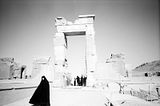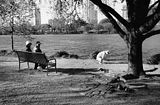
Participating in:
Shadow Shot Sunday &
Monochrome Monday
Please follow the link to check other participants' photos.
Monday, January 26, 2009
Monochrome Shadow (Shadow #005)
Sunday, January 18, 2009
Shadow #004

This is just a snapshot from around my office on a sunny late afternoon and a Shadow Shot Sunday for everybody to enjoy.
Wednesday, January 14, 2009
Sunday, January 11, 2009
Shadow #003

I have posted two photographs on this blog exploring the shadows before: here and here. This third post of shadow exploration is my first participation in the Shadow Shot Sunday (SSS) meme. To see other participants' photos exploring the beauty of shadows, please follow the link.
Saturday, January 10, 2009
Color Harmony and The Production of Aesthetic Images (Part One)
"Our response to colours is complex, involving reactions at an emotional, subjective level to physical facts of light at different wavelengths." (Michael Freeman, 2005)
As common and ordinary as it is, color is a complex phenomenon. As the above quote aptly put it, discussing color is basically discussing about our response to it. That response may be scientific - as that made by physicists and/or chemists - or aesthetic - like that made by artists, designers, and photography practitioners like ourselves.
When it comes to the issue of the production and assessment of beauty, which I believe what aesthetic is essentially about, the nagging question about color is what makes certain combinations of colors harmonious or pleasing to look at?
Many of us (read: artists, designers, photographers, or even ordinary consumers or art works) would probably just say it's a gut instinct. We just know it and can feel it when a certain combination of colors is right. But this answer will of course be confusing to those who do not have the "talent" for that kind of gut or those who are learning to understand how colors work the magic in a pleasing composition. So what do aesthetic theories say about it?
According to art historian John Gage, the theory of harmony can be classified into four. The first of these views harmony as or in terms of scale, just like that of music. Then there are also theories that consider harmony in terms of complementary relations, resemblance in the level of brightness/value, and the psychological response given by the subjects. In addition to these, there are also others who say that hues and expectations may also play a significant role in the construction of what is considered to be a harmony.
That being explained, we may also ask another question, that is, if harmony is really the issue when it comes to composing colors (or other elements for that matter) in the making of beautiful images? Certainly art (including photographic art) is not just about harmony. As many art connoisseurs know, elements of discord can sometimes also play a role in the making of aesthetic objects. However, I don't think this is the right place to wage on this kind of argument. Let us just concentrate on the issue of what is pleasing about color composition.
Text and photo by Eki Akhwan
To be continued in the next part.
Saturday, January 3, 2009
Photographing at Festivals: Faces in The Crowd


If you enjoy street and action photography, festivals are the place to go. Festivals offer actions and colors in a single place that only a few other scenes can match.
However, a festival is not only a place where you can capture staged actions; it's also an excellent venue for candid people photography. This is what I usually do when I can't get a perfect spot to capture the actions: I turn my camera to the spectators. They can provide pictures as lively and fascinating as those of the event itself.
What do you need to do to get good candid photographs of people at festivals?
Scan the crowd often and look out for interesting faces and expressions. People cheering and laughing on a performance, for example, can make marvelous subjects for candid photography. Sometimes, when you get lucky, you can also find a rare candid moment of people doing things that is otherwise hard to get anywhere else. Just a couple of weeks ago while I was photo-hunting at a festival, I spotted a child playfully running and playing among the crowd while his mom was chasing after him. The scene was very expressive and was a perfect candid photo op of people.
There are basically two approaches you can take about capturing faces in the crowd. First, you can use a telephoto lens. This kind of lens is very useful especially when your position is at a distance away from the scene you want to photograph. The shallow depth of field and the narrow view of a telephoto lens enable you to isolate the subject and throw the background details out of focus. The characteristics of telephoto lens, which as you know tend to compress perspective, may also come in handy especially when you want to capture the different facial expressions in the crowd.
If you only have a standard or wide angle lens, or if you happen to be in the middle of the crowd, take advantage of your position by looking for interesting subjects near you. Unlike the first approach with the telephoto lens where you can observe your subjects from a "safe" distance and somewhat take your time in choosing and aiming at your subject, the use of standard or wide angle lens requires that you aim and focus swiftly, so that you don't lose the candid moment in front of you. (Remember, the subject's awareness of the presence of your camera can change the scene from candid to posed, which of course will make your photograph less interesting.)
Text and photos by Eki Qushay Akhwan.
Unless otherwise stated, the articles and photos in this blog are the copyright property of Eki Qushay Akhwan. All rights reserved. You may NOT republish any of them in any forms without prior permission in writing from Eki Qushay Akhwan.
Kecuali disebutkan secara khusus, hak cipta atas tulisan dan karya foto di dalam blog ini ada pada Eki Qushay Akhwan. Dilarang mempublikasi ulang artikel dan/atau karya foto di dalam blog ini dalam bentuk apapun tanpa izin tertulis dari Eki Qushay Akhwan.










.jpg)








